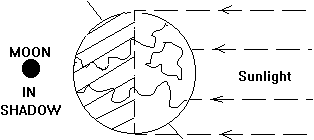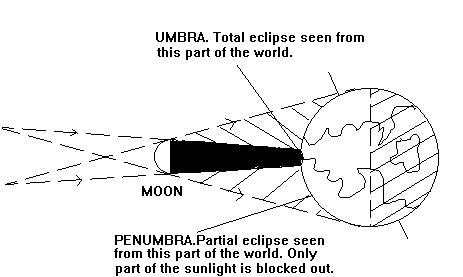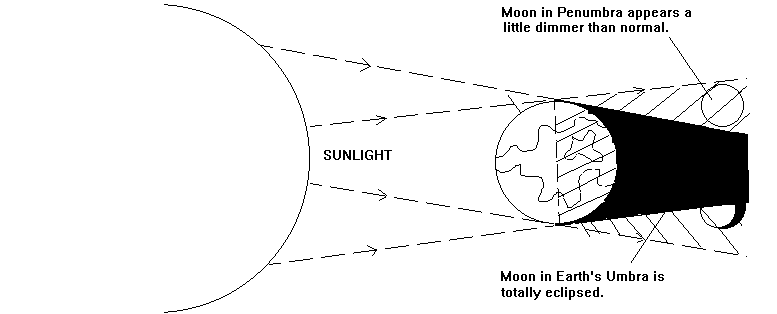
 PREVIOUS PAGE
PREVIOUS PAGE
Eclipses
There are two types of eclipses, a Solar eclipse, (an eclipse when the Sun goes dark ) and a Lunar eclipse (an eclipse when the Moon is covered by a shadow ).Eclipses happen when the Moon and Earth fall into line with each other and the Sun.
Very occasionally the Earth moves into a direct line with the Moon between itself and the Sun . The Moon blocks out the Suns light for part of the Earth's surface and produces a Solar eclipse.

Similarly the Earth comes between the Moon and Sun and causes a Lunar eclipse.

Solar Eclipses
The Sun is roughly 400 times the diameter of the Moon but it is also 400 times further away from the Moon than we are. So from the surface of the Earth the Moon and Sun appear approximately the same size. Consequently, when the Moon moves between the Earth and the Sun, the Moons disk is exactly the right size to cover the Sun's disk completely. However not all points on the Earth see the same Solar eclipse at any one time. It can only be seen in places that are directly within the Moon's shadow.
Umbra
The shadow that the Moon casts upon the Earth has two regions. The main part of the shadow, which is directly in line with the Sun, is called the Umbra.This is the point where all light from the Sun is blocked out and a total Solar eclipse is observed.
Penumbra
The other region of shadow is called the Penumbra and this causes a partial eclipse. The shadow this casts is not as dark as the Umbra and so only blocks out some of the sunlight.

Lunar Eclipses
These happen when the Earth moves into a direct line between the Sun and the Moon stopping all light from reaching the Moon.
Total Eclipse
The Moon becomes totally eclipsed when it moves into the Earth's Umbra shadow. It is very rare that the Moon becomes invisible by these means. A total Lunar eclipse will last for much longer than a Solar eclipse, usually two to three hours.
Partial Eclipse
A Partial eclipse happens when part of the Moon is in the Umbra. Another less well observed eclipse is when the Moon enters the Earth's Penumbra.This has the effect of dimming the Moon a bit.

 Back to Solar System Contents Page
Back to Solar System Contents Page